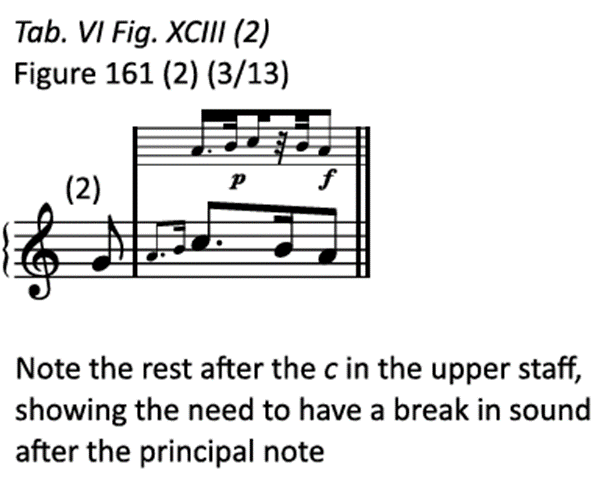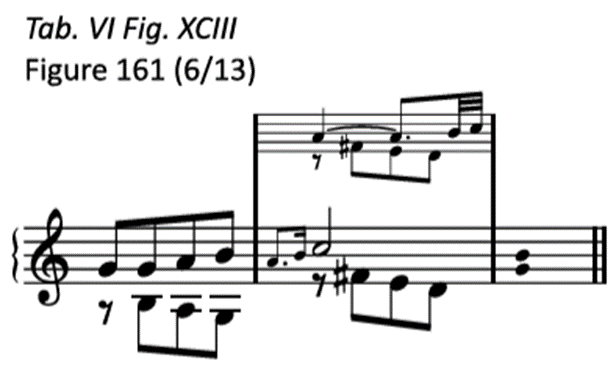C.P.E. Bach: Versuch über die wahre Art das Clavier zu spielen
(Part One 1753, Berlin)
(Essay on the True Art of Playing Keyboard Instruments)
I am always interested in original sources, and this is one of the best for keyboard players. C.P.E. would have formed many of his ideas from his father, the great J.S. Bach. At the same time, he was very much part of the next generation and was well known and respected on his own merits. It is well worth the effort to study the text either in the original German or the English translation. Having made my way through both, it takes time to wade through the antiquated writing style and sort out the musical examples. The following study guide is intended to make the text more accessible by providing a summary of each paragraph along with audio clips of the musical examples.
Study Guide: Summary and Examples
Chapter Two, Embellishments: The Slide
THE SLIDE
1) The slide:
- Appears with or without a dot
- It is played as its name “slide” suggests
- Melodies are made more flowing with its use
2) The undotted slide:
- Consists of 2 or 3 small notes played before the principal note
3) Notation of the slide:
- A 2-note slide is notated with small 32nds (Figure 156)
- In an alle breve tempo they may be notated as small 16ths (Figure 156 asterisk example)
- Sometimes notated as in Figure 156 (a) or with large notes as in Figure 156 (b)





4) 2-note Slide vs. 3-note slide
- 2-note slide is always used in a leap with the purpose of filling in the gap (note the examples in Figure 156 above) vs. the 3-note slide can be used this way as well as other ways
- 2-note slide is always played rapidly vs. the 3-note slide can be played rapidly as well as slower
5) The 3-note slide (a.k.a. an inverted turn although C.P.E. does not use this term)
- Figure 157 shows the execution
- Speed is determined by context
- C.P.E. suggests the notation of an inverted turn symbol shown in 157 (b) (this did not become standard practice however, and is more often notated with large or small notes)


6) 3-note slide used in rapid passages
- Can be used in very fast or very slow tempos, flowing or highly expressive movements
- Rapid passages
- fills out notes and adds sparkle
- takes the place of an ascending trill where it cannot be used due to short note values
- always performed rapidly in these cases, the following note may either be a leap or a step




7) 3-note slide used in slower passages
- Well suited to expressions of sadness, adagio movements
- Slow, expressive passages
- Should be highly expressive and not played in strict time, can be halting and subdued
- Most found over repeated note (Figure 159 (a)
- May appear after an ascending step or leap (Figure 159 (b)
- Resembles a slow compound appoggiatura with its interval of a third filled in
- Long notes may be expressively divided and ornamented by it (Figure 159 (c)





8) The 3-note slide is found:
- In slow passages: more often over a dissonance (which conveys expression more than consonance), over slow notes whose values are not completely filled out on purpose, or filled out in a halting manner
- In fast passages: also decorates an expressive moment, such as a change from major to minor
- Chords which go well with this ornament:
- Diminished 7th
- Augmented sixth when it contains a fifth
- The sixth with an augmented 4th and minor 3rd
- Other similar accompaniments
- This ornament tends to move downwards because of the typical bass accompaniment context
9) The slide demonstrates 2 things regarding expression:
- (1) In certain passages, it is more important to convey a restrained expressiveness rather than focus on filling out notes.
- (2) This does not mean that fewer notes in an ornament equal more expressive.
10) The Dotted 2-note Slide
- The 3-note slide is effective for conveying sadness
- The dotted 2-note slide is effective in conveying happiness
11) The notation of the dotted 2-note slide is shown in Figure 160. The execution is extremely variable and determined by the affect. C.P.E. has taken care to notate it and specify its execution as clearly as possible in the examples.


12) Examples:
- Most of the examples show contexts that are especially suited to the slide rather than other ornaments
- If the passage is played without ornamentation, something is needed, either because of the harshness of the dissonance, or the emptiness of the octave.
- No ornament besides the slide fits these situations better
- The following tone usually descends (but note the example marked “X” shows an exception)


Examples with commentary in the text:
- The asterisked division of the slide is better than the following one because of the bass

- Example “X” shows that although the following tone usually descends, the melody may continue by repeating the final tone of the slide

13) Examples showing details of the performance and execution
- Examples 1 and 2 show that although the dotted tone in the slide is emphasized, the next two notes are played softly.
- Example 1: Note the dot under the principal tone “e” in the upper staff showing the execution shows that note should be released before the next tone sounds

- Example 2: Here a rest is used in the upper staff showing the execution instead of a dot to show the same effect as Example 1, i.e. the principal note “c” should be released before the next tone sounds

(Remaining examples without specific commentary in the text shown below)









SOURCES
Bach, C.P.E. Essay on the True Art of Playing Keyboard Instruments. Translated and edited by William J. Mitchell, W.W. Norton & Company, 1949, pp. 136-142.
Bach, Karl Philipp Emanuel. Versuch über die wahre Art das Klavier zu spielen. Edited by Walter Niemann, C.P. Khant, Leipzig, 1925, pp. 73-77.
CLICK HERE to download a pdf version of this study guide